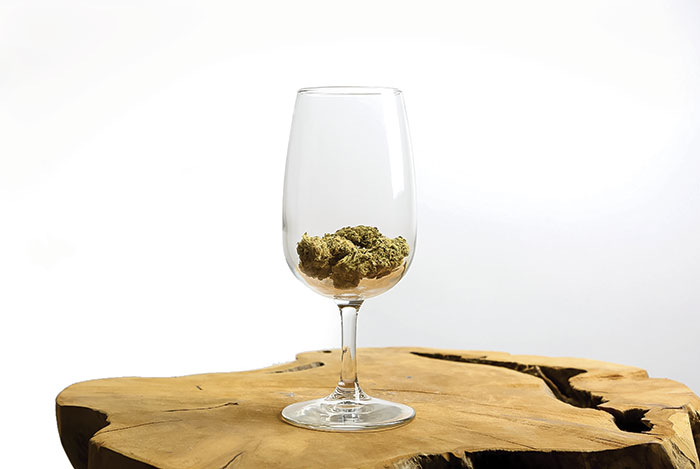
Cannabidiol Brews
An Ode to Hops’ Twin Sibling
Have you ever seen The Parent Trap? The 1998 version with Lindsay Lohan and Dennis Quaid? Let me summarize: two girls meet each other at summer camp and discover that they’re long lost twin sisters.
Now let’s reimagine a more adult version with two of America’s favorite vices: hops and hemp, aka cannabis. Much like the two Lohans, hops and hemp are long-separated siblings of the same family (the Cannabaceae, for those curious). But instead of summer camp, the two plants met at the 2015 Great American Beer Festival, where Colorado-based Dad and Dude’s Breweria unveiled what was at the time the world’s first CBD-infused beer: the Indica Double IPA.
CBD, also known as Cannabidiol, is one of the compounds found in cannabis. Unlike THC, the compound that gets you high, CBD is non-psychoactive. It does, however, offer anti-inflammatory, anti-depressant, analgesic, and anti-oxidant properties — as well as an aromatic quality and smoothness to the beer. Some also believe the addition of CBD to beer proves to be the cure-all for hangovers, though this is purely anecdotal.
Now, with the state-by-state softening of marijuana prohibition in America, there are plenty of options for those looking to drink some brews with some buds. Coalition Brewing, based in Portland, OR, is releasing the state’s first CBD-infused beer. Their process begins with a base West Coast IPA, then adds hemp juice and CBD oil. The final product is equal parts bitter from the hemp juice and citrusy and aromatic from the CBD oil.
Other examples include OG HighPA Session IPA from San Diego’s Thorn Street Brewery, Hippie Joe’s Hemp IPA from Eugene’s Mancave Brewing, and Homegrown Hempen Ale from Duluth’s Fitger Brewing.
Because they use CBD and not THC, none of these will make you fail a drug test or even get you stoned. But for those who are legally allowed, and want to, there’s the New Frontier Brewing Eureka!, a 24-ounce beer that boasts 25 mg of THC — enough to keep you high for quite a while.
If you’d still prefer not to take the chance, there are plenty of hemp-inspired and hemp-paired beers: for instance, SØLE’s Kushy Clouds, Ale Industries’ Cherry Kush, and Oskar Blues’ Blue Dreams. And both Lagunitas and Dark Horse have had beers rejected by the Bureau of Alcohol, Tobacco, Firearms, and Explosives because of their references toward hemp-culture.
Whatever your choice, imbibe safely, legally, and — most importantly — with good beer.
— Text & Photography: Hop Culture Studios

Maine Beer & Ice Fishing — Coming to a Shanty Near You
When gathering supplies for a day of ice fishing on one of Maine’s seemingly infinite lakes and ponds, there’s only one thing more vital than tip-ups, a bucket of smelt, and thermal underwear — that is, of course, beer. Nothing keeps the cockles of the heart as warm as beer when the wind whips along an ice-capped lake in February.
Light beer rules the day when it comes to a day-long ice fishing outing; though it’s good to sprinkle in a few high octane brews for some alcohol heft when the mercury nose dives. Instead of 30 packs of macrobrew swill and nips of the nauseating Fireball Whiskey, here are some Maine brewed libations to pack in the cooler for a day of chasing flags as you wait for the big one to bite.

Barley Wine ~ Sebago Brewing Co.
Now that your cooler is packed with a lager, it’s time to punctuate your beer intake with a warm-the-gut, barrel-aged beer. Weighing in at 11.8-percent and packing oodles of complexity in flavor, the Barley Wine from Sebago Brewing is the perfect beer to celebrate that 18-inch brown trout you just pulled out of Sebago Lake. Barley Wine is aged in bourbon barrels and boasts notes of roasted toffee, caramel, vanilla, and currants, with a subtle bourbon finish. Packaged in an inventive sleeve of two 12-ounce cans stacked on top of each other, Barley Wine is easy to toss in a cooler along with your lagers. It’s refreshingly unpretentious for a complex barrel aged beer—and we all know that pretension is the nemesis of ice fishing.
Curieux ~ Allagash Brewing Co.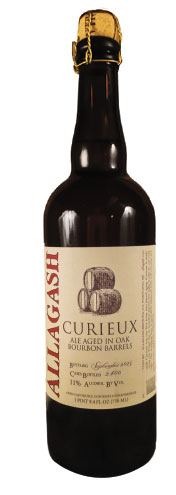
Speaking of bourbon barrel aged beers, there is none finer than Allagash Curieux. Allagash ages its Tripel ale in bourbon barrels, then blends the barrel-aged beer with fresh Tripel to create the beautifully balanced, brimming with complexity Curieux. Allagash claims there’s a hint of bourbon in flavor, but I’ll contend that the bourbon is quite pronounced in Curieux—which is what I love about this beer; it has an assertive bourbon backbone without being too boozy in flavor. Along with notes of buttery bourbon, there are flourishes of vanilla, oak, honey, and bright Belgian yeast notes. At 11 percent, this one will keep you warm, and like the Barley Wine above, it should be imbibed responsibly. Despite its fancy cork-top, this beer isn’t too pretentious for a day of ice fishing. Pop the cork when it’s time to celebrate that fat rainbow trout your buddy just landed or as a way to brighten a day when you’re being skunked on the lake.
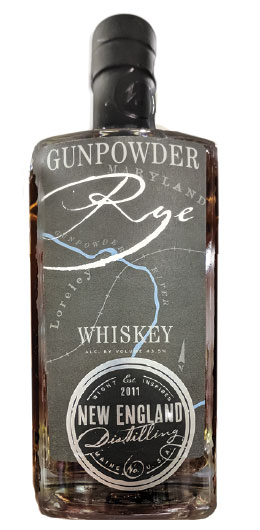 Gunpowder Rye Whiskey ~ New England Distilling
Gunpowder Rye Whiskey ~ New England Distilling
If you’re heading out on a day when the temperature refuses to rise above zero degrees, you’ll need something stronger than beer to keep you warm. Luckily, Maine has more than a dozen distilleries making a wide range of spirits. And no spirit has been warming the bones of Mainers longer than whiskey. I suggest you tuck a flask filled with Gunpowder Rye Whiskey from New England Distilling in your jacket pocket to keep Jack Frost at bay. Gunpower Rye is a Maryland style whiskey, meaning it’s mashed with mostly rye instead of corn. This imparts a spicy and herbal flavor profile that offers the boozy bite of a spirit with more complexity than traditional whiskeys. Aged in American oak barrels for up to a year, Gunpowder Rye has notes of roasted vanilla, oak, and an earthy spiciness. When the west winds howl, fight back with a tipple of Gunpowder Rye Whiskey.
Pepperell Pils ~ Banded Horn Brewing Co.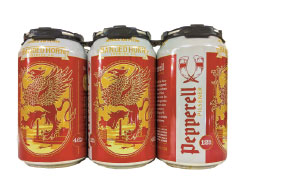
Maine has a dozen beautifully crafted lagers to choose from for an ice fishing excursion. For my money, Pepperell Pils from Banded Horn Brewing in Biddeford is the pilsner of choice for a day out on the lake. Brewing a crisp, clean lager is no simple task, making the refreshing Pepperell Pils a triumph of light beer. This beer releases an inviting graham cracker and floral hop aroma when you crack a can, while the flavor is dangerously drinkable with notes of fresh bread, spicy lager yeast, and an earthy hop finish. The 4.6-percent alcohol content allows you stay satiated, while still on your game for running after tripped flags. This beer glides over the palate like Bean boots over the smooth surface of a frozen pond. Grab a sixer or two to toss in the cooler for your next trip.
— Text: Dave Patterson. Dave is a freelance writer with a great thirst for craft beer. His Beer Muse column runs each week in the Portland Press Herald.
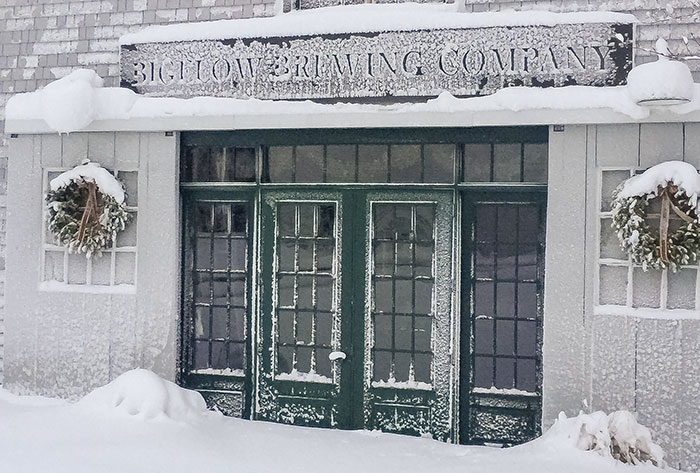
A Snow Day with Bigelow Brewing Company
On the first day of November, Pam and Jeff Powers, co-founders of BIGELOW BREWING COMPANY, are gearing up to take a five-hour road trip to scoop up 100 pounds of cranberries. Their dedication to sourcing as many ingredients from Maine as they can for their brews is why they’ll drive 2 ½ hours from Skowhegan to SUGAR HILL CRANBERRY CO. in Columbia Falls, Maine, and then back again with the freshest cranberries. That will produce at least 15 barrels of their holiday brew, Cranberry Peak, an amber colored ale brewed with Maine malted barley, Galena and Kents Golding hops.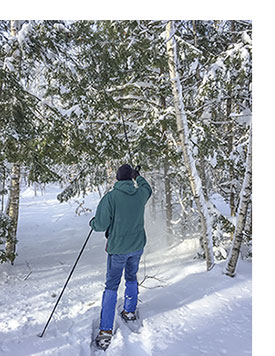
“BIGELOW BREWING has a belief that beer can and should be about a place,” said Pam, who, along with husband, Jeff, founded BIGELOW BREWING COMPANY in December 2013. “We strive to make beer from our community, using local ingredients to feel a sense of ownership of where we live.”
“We source as many local, Maine products for the beer as possible,” she said. “A hundred percent of our base malt in every beer we make is Maine grown. We use local maple syrup from Smith Brothers Maple and Strawberry Hill, sap houses that are within walking distance from our brewery for our Rowe Road Maple Porter. Avery Peak Summer Wheat uses wheat berries from the Porter Farm and Aurora Mills in Aroostook County. Maine Grains and Aurora Mills provide rolled oats for our Bigelow Brown Ale and Jailbreak Chocolate Chili Stout. Witch’s Tit Pumpkin Ale is made with organic pumpkins sourced from Moodytown Gardens in Palmyra, Maine. The pumpkins are roasted in our Maine Wood Heat Co. wood-fired oven before peeling and putting them in the mash. Using local products is a chance to support small farmers and preserve our agricultural heritage.”
With an on-premises hop field, featuring Cascade and Centennial hops, Jeff was able to brew the pumpkin ale with their fresh Cascade hops and develop a new seasonal, Hop Yard Harvest, utilizing both Cascade and Centennial hops.
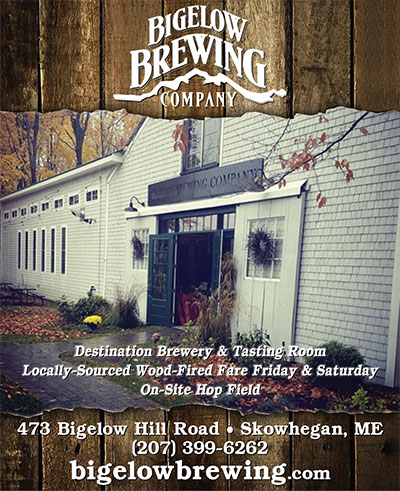 Like many on-trend breweries, BIGELOW BREWING also makes great use of its spent grains. Two years ago, they contacted their local bakery, THE BANKERY, to produce a pizza dough using their spent grains. The end product is a versatile pizza dough made with spent grains and flour milled from the local grist mill that is for Bigelow Brewing’s specific use. With the addition of a full time chef, they continue to find creative ways to use spend grains in products such as granola, baguettes, and toppings for desserts to name a few. The Le Panyol wood-fired oven is stretched to its limits every Friday and Saturday throughout the year, serving pizza topped with locally sourced meats, cheeses and toppings, paired with Bigelow’s fresh craft beers.
Like many on-trend breweries, BIGELOW BREWING also makes great use of its spent grains. Two years ago, they contacted their local bakery, THE BANKERY, to produce a pizza dough using their spent grains. The end product is a versatile pizza dough made with spent grains and flour milled from the local grist mill that is for Bigelow Brewing’s specific use. With the addition of a full time chef, they continue to find creative ways to use spend grains in products such as granola, baguettes, and toppings for desserts to name a few. The Le Panyol wood-fired oven is stretched to its limits every Friday and Saturday throughout the year, serving pizza topped with locally sourced meats, cheeses and toppings, paired with Bigelow’s fresh craft beers.
Not only do they strive to keep other local purveyors in business, but Jeff and Pam also have a strong commitment to their community. “One of the things we love about Maine and specifically the Skowhegan community, is how local customers and businesses support one another,” said Pam. Since opening, they’ve donated the space of the brewery for multiple fundraisers, from nonprofit organizations to individual family-and-friends events, ensuring that all proceeds go back to the organizers and the community.
“Every brewery in this state gives back to their community in some way and I think that’s significant,” said Pam. “With numerous manufacturing industries closing and moving out of Maine, it’s important for us to take care of our community and help out wherever we can.”
BIGELOW BREWING is located on the local Skowhegan Sno Hawks Snowmobile Club trail #33, a connector to ITS 87 in Norridgewock and with wooded trails on their 25-acre premises, they’re open to the public to snowshoe and cross-country ski. It’s worth checking them out this winter—maybe get a bite of locally sourced wood-fired pizza and sample a Cranberry Peak ale or any one of their IPAs, stouts or porters.
As owners Jeff and Pam like to say, “Bigelow brew is always a great companion for your next outdoor adventure!”
— Text & photos: Bigelow Brewing Company

The first time I met David Geary
Moose Drool, Umpa Lumpas, and Hipsters: A Look Back at My First Beer with David Geary
The first time I met David Geary, I was nervous. Geary is a legend in the world of Maine brewing. Being new to beer writing at the time of that first meeting, I had placed Geary on a pedestal. And, rightfully so.
After all, I told myself as my car idled in the brewery parking lot, this is the guy who opened Maine’s first post-Prohibition brewery in 1986. He is the original gangster of Maine beer.
As I stared at the brewery’s brick façade, I remembered the stories I’d heard that Geary was a bit of a crank.
“Don’t piss him off,” one local beer writer had cautioned. “He’ll kick you out of his brewery!”
Add to all this the fact that Geary’s didn’t have a tasting room at that time. While every other Portland brewery was constructing tasting rooms and inviting beer fans into their brewhouses, no one I knew had ever been inside D.L. Geary’s Brewing Company. The brewery had garnered something of a Wonka Factory reputation, leaving beer lovers to speculate about what the heck was happening inside those beige brick walls.
After reading over my notes and underlining the warning, Don’t piss him off, I shut off my engine, got out of the car and headed in to meet the founding father of Maine brewing.
Instead of being greeted by a chorus of impish Umpa Lumpas when I walked inside the brewery, a chocolate lab lazily licked my outstretched hand as I pushed through the office door.
I told the woman at the front desk I was here to interview David Geary about his new gluten-free beer, Ixnay.
From an office behind me, a gruff voice yelled, “Send him in!” The woman at the desk motioned towards the office and said, “Go ahead.”
What first struck me about David Geary was the boyish charm that shone through the exterior of a man pushing 70 years old.
“So, you write about beer?” Geary asked me with a wry smile. “Someone actually pays you for that?”
Taking a seat in a chair in front of his desk, I laughed and said, “Yeah, it’s pretty great.”
“Not bad,” Geary nodded. “Not bad at all.”
I looked around at the office that hadn’t seemed to changed much since the late 1980s: the chocolate lab was curled on the faded brown carpet, a mammoth computer monitor sat on his cluttered desk, and an aging mini-fridge hummed in the corner.
Before I could ask Geary any of my prepared questions about his new gluten-free beer, he launched into an unsolicited diatribe, bemoaning the new beer movement of cloudy, excessively hopped IPAs that, according to him, had the stupidest names.
I sheepishly admitted that I liked a lot of these cloudy IPAs and waited for him to kick me out of his brewery.
He studied me with his crystal blue eyes, and finally said, “There’s a beer called Moose Drool. Moose Drool!” We both laughed. He demanded that when I got home after the meeting I watch a YouTube video called, “Hipsters Love Beer,” a sketch video satirizing the over-the-top nature of the craft beer movement. (If you haven’t seen it, check it out. It’s hilarious.)
I learned a lot about David Geary during our hour-long meeting that day. First off, I learned that there were no Umpa Lumpas in his brewery, or if there were, he kept them well hidden.
Secondly, despite his aversion to the nouveau beer movement, the man truly loved beer. When he poured us two glasses of Ixnay, he held up his pint glass and we both gazed at the liquid.
“Look at how clear and beautiful this beer is,” he said with reverent tone bordering on beatific.
Finally, I learned that David Geary is an old crank—albeit, the best kind: a wonderful, hilarious, kind-hearted old crank.
Each time I’ve run into Geary since that first meeting, he’s continued to be nothing less than that warm curmudgeon he was three years ago in his office; though he still gives me a hard time that I described him as ‘ruddy faced’ in the ensuing article I wrote about our meeting.
As David Geary steps away from his role as owner and operator of D.L. Geary Brewing Company, let’s collectively raise our pint glasses to the man—no matter how hazy the beer inside the glass may be or how stupid the beer’s name.
— Text & Photos: Dave Patterson. Dave is a freelance writer with a great thirst for craft beer. His Beer Muse column runs each week in the Portland Press Herald.
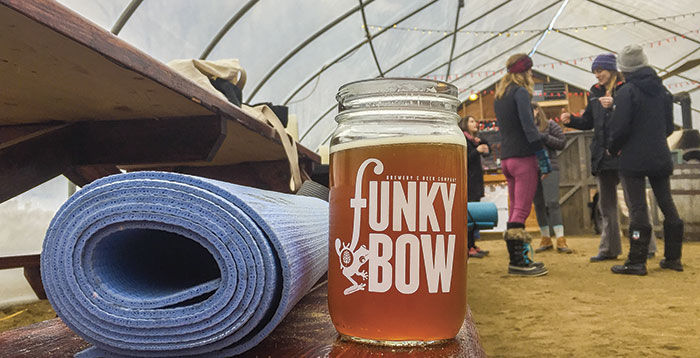
Beer + Yoga
Fitness, community, and Maine’s craft brewing scene
THERE WAS A TIME WHEN THE WORDS “YOGA” AND “BEER” WEREN’T OFTEN SAID IN THE SAME SENTENCE. They seemed like divergent concepts—or at least different enough that you had to change clothes when you went from one to the other. But in the Venn diagram of extra curricular choices in Maine, beer overlaps with just about everything. Yoga included.
Some brew-loving yogis have known this for ages. Much like our friends who hike or run and then meet up afterward at a local bar to socialize over a glass of beer, people who do yoga sometimes like a post-savasana drink, too. And while popular opinion 20 years ago might have paired yoga with kale shakes and beet juice smoothies (which are, for the record, also lovely), modern-day fitness fans think differently.
Yoga and beer pair very well together.
Here in Maine, yoga has grown increasingly popular over the last decade. New yoga studios are popping up all over state, offering classes for a range of abilities and styles (yoga for runners, aerial yoga, and paddleboard yoga, just to name a few). The local craft brewing scene has grown dramatically at the same time—from more than a dozen Maine breweries in 2007 to approximately 100 today. It’s no wonder that someone finally saw fit to combine the two.
But actually doing yoga in a brewery or tasting room itself, well that’s still a relatively new phenomenon. And we love it.
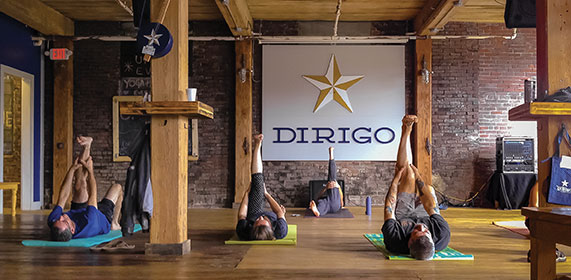
Photo: Shannon Bryan
“I think a lot of people hear ‘yoga’ and picture people sitting in a studio, incense burning, chanting ‘Ohm’ and contorting themselves into unnatural shapes,” said Annie Leslie, a yoga instructor who teaches classes at Run of the Mill in Saco and Funky Bow Brewery in Lyman. “But when people hear ‘yoga… oh, but there’s beer after,’ their image turns into something a little less foreign and a little more fun.”
It’s a combination that helps encourage people who might be hesitant to walk into a traditional yoga studio for the first time, she said.
More experienced yogis who love beer also benefit. “I don’t think that there is a single person on this planet who cannot benefit from yoga,” said Annie. “It’s beneficial for both the body and the mind and not only reduces physical pain, but also helps things like stress and anxiety.”
It’s a fun change of pace in a welcoming and relaxed environment. And the post-yoga beer invites people to stick around, meet each other, and socialize for a while.
“People want to be healthier and work on their fitness goals in a supportive social setting,” said Kat Cynewski, owner of Be Well Portland, a fitness-based social events company that hosts events around Portland, from boot camp with Shipyard to Bend and ‘Booch at Urban Farm Fermentory. “But they also love to enjoy themselves and indulge,” she said. Be Well Portland events aim to balance the two.

Photo: Shannon Bryan
“Generally, people unwind by getting active or having a drink, and I’ve witnessed both activities done in excess, but here, in balance, it’s really the best of both worlds,” said Kat. “On top of that, it brings people together in a supporting and lighthearted way to strengthen their sense of community.”
Many brewers see the perks, too. Molly Sinclair Bull, co-owner of Dirigo Brewing Co. in Biddeford, is an avid yogi herself, and she understands the benefits of having class at the brewery. “At class every Sunday, we get together to share and rededicate our common purpose, and with practice, we are better equipped for all the daily challenges. After class, new and old friends can enjoy each other’s company with a refreshing glass of beer. Sure beats church,” she joked.
It all makes for a memorable experience that’s worth checking out.
“Whether you’re coming for a challenging work out or the amazing post-class beverages, you’re bound to have a great time,” said Kat.
Learn about Yoga + Beer Classes in Maine
— Text: Shannon Bryan. Shannon loves to get active in Maine – from aerial yoga to moonlight paddles — and she writes about them all (to encourage you to try them too!) on FitMaine.com.

Mix a Six: 6 beers to cozy up with by the fire
Now that the seasons are shifting, our palates are shifting along with them. Gone are the crisp kolsches and session IPAs of summer, replaced with burlier brews. Fall seasonals — and other styles that are just a little more autumn-appropriate — tend to be maltier than their summer counterparts, with a touch more sweetness and a bit more alcohol to boot. They’re also where the kitchen cabinetful of spices start to appear, not just in the love-‘em-or-leave-‘em pumpkin beers, but in any number of winter warmers. As you bust out the flannel and gather around the fire, here are six brews to match the season.
Shipyard Old Thumper ~ A year-round offering from the venerable Portland brewery, the malty Old Thumper was created by the Ringwood Brewery’s Peter Austin (mentor to Shipyard’s Alan Pugsley). The ESB makes good use of the brewery’s signature yeast strain, its telltale butterscotch flavor balancing the biscuity malt.
Lone Pine Chaga Stout ~ While your instinct may be to associate Chaga mushrooms with kombucha, a handful of Maine brewers have been putting the “King of Medicinal Mushrooms” in their beers. Lone Pine’s limited Chaga Stout, brewed in partnership with North Spore Mushrooms, harmoniously combines a stout’s traditional roasty backbone with notes of vanilla and spice.
Sebago Bonfire Rye ~ Rye has become a popular part of the malt bill for a number of cool-weather beers, with its spicy flavor adding a warming touch to otherwise sweet beers. Sebago’s Bonefire Rye leans into the malt character but flips the script with a generous late hop addition, which gives a pleasantly piney, resinous finish.
Lake St. George Danny’s Oatmeal Stout ~ Nothing welcomes cooler weather like a stout, and no one brews an oatmeal stout like Lake St. George’s Danny McGovern. A malt bill of oatmeal, wheat, and barley, Danny’s Oatmeal Stout creates a pillowy-soft body and creamy finish. Some people think of stouts as heavy, filling beers, but I challenge you to drink just one of these in a sitting.
Bunker Bunktoberfest ~ A pitch-perfect take on the traditional German festbier, this märzen combines a hint of bitterness with a toasty, bready body and pleasantly dry finish. This fall, Bunktoberfest is coming out in 16oz “pounder” cans — a first for Bunker, and the perfect size for quaffing by the campfire. Prost!
Baxter Hayride ~ A trio of spices — ginger, black pepper, and orange peel — add some warmth to Baxter Brewing Company’s fall seasonal. Brewed with rye malt and aged on oak, Hayride has a slight spiciness that pairs perfectly with New England’s traditional fall foods. The citrus zing of New Zealand hops softens the spiciness beautifully.
— Text: Josh Christie. Josh is the author of a number of books on beer and the Maine outdoors, and co-owner of Print: A Bookstore in Portland, Maine.

The Maine Beer Trail: Great Hikes, Great Views
Hiking adventures and great brews abound along the Maine Beer Trail
Autumn is the perfect time for hikers to pursue their love of the outdoors and passion for beer on the Maine Beer Trail, which showcases the state’s wealth of breweries and brewpubs. Good beer and tasty food are standard fare on this great adventure, and when paired with Maine’s four million acres of conservation lands and more than 1,000 miles of hiking trails, you’ve got a recipe for lots of healthy exploration and good fun.
“We expect to have more than 100 licensed breweries in Maine by the end of 2017,” said Sean Sullivan, Executive Director of the Maine Brewers Guild, which developed the Maine Beer Trail eight years ago. “It’s an awesome time for beer drinkers in this vast world of beer. There’s a style for every palate.”

Sargent Mountain Trail, Acadia
One notable pairing of hikes and brews is found on Mt. Desert Island, where Acadia National Park’s 130 miles of trails wind through a paradise of pink granite ridgetops, tranquil forested valleys, pristine ponds, and bold oceanfront cliffs. Cadillac Mountain, Penobscot Mountain, Jordan Pond, Hunter’s Brook and Wonderland are all favorites. When the hiking is done and your thirst is at its peak, head to ATLANTIC BREWING COMPANY’s new Midtown pilot brewery in downtown Bar Harbor to sample an interesting menu of small batch beers and enjoy fresh, locally sourced food.
“We wanted to do something different, so we’re experimenting with many styles of beers,” said Alex Maffucci, Atlantic’s co-owner, Director of Operations and one of three brewers. “Our focus is on variety. We talk to patrons, staff and brewers and ask, ‘what would you like to see?’ We make the beers as one-offs, then we’re on to something new.”
Fall is here, so get your hiking gear together, grab a copy of the Maine Beer Trail Passport, and go! Try these other fine boots and brew combos for starters.
KITTERY: On the Cutts Island Trail, walk through oak and pine forests and along tidal estuaries and salt marshes in the Rachel Carson National Wildlife Refuge. At TRIBUTARY BREWING COMPANY in the central village, the flagship beer is Tributary Pale Ale, but it’s Mott the Lesser, a Russian Imperial Stout, that really sets the brewery apart.

Little River Community Trail in Belfast
BELFAST: Minutes from downtown, the Little River Community Trail wends from the old brick pump house and outlet dam on US 1 around the undeveloped shores of two reservoirs. On the waterfront, MARSHALL WHARF BREWING COMPANY and THREE TIDES RESTAURANT feature 17 draft lines dedicated to their beers. Try the classic Tug Pale Ale.
LIMERICK: Hike the Smith Trail to the top of Sawyer Mountain, which lies amid the largest unfragmented block of undeveloped forestland in York County. GNEISS BREWING COMPANY, a back-to-the-land operation in the rural woods of town, specializes in German-style wheat beers. Gneiss-weiss is their very drinkable flagship beer.
SOUTH PARIS/NORWAY: The distinctive west face of Streaked Mtn. in South Paris can be seen for miles around. A short, steep hike leads to the summit ledges. On Main St. in Norway, the interior of NORWAY BREWING COMPANY has the look and feel of an old farmhouse. Mr. Grumpy Pants Oatmeal Stout, the signature beer, is made with Maine Grains oats and Coffee by Design roasted beans.
MONTVILLE/LIBERTY: The Northern Headwaters Trail in Montville leads along old stone walls on Whitten Hill to the headwaters of the Sheepscot River. Housed in a modernized 100-year old post and beam hay barn in Liberty, LAKE ST. GEORGE BREWING COMPANY produces a line of traditional beer styles. The 96 IPA, named for their brewing license number, is most popular.
HIKES & BREWS RESOURCES
MAINE BEER TRAIL
AMC Maine Mountain Guide
AMC’s Best Day Hikes Along the Maine Coast
Appalachian Mountain Club – Get Outdoors | AMC
— Text & photos: Carey Kish. A resident of Mt. Desert Island, Carey is an avid beer drinker, editor of the AMC Maine Mountain Guide, and author of AMC’s Best Day Hikes Along the Maine Coast.
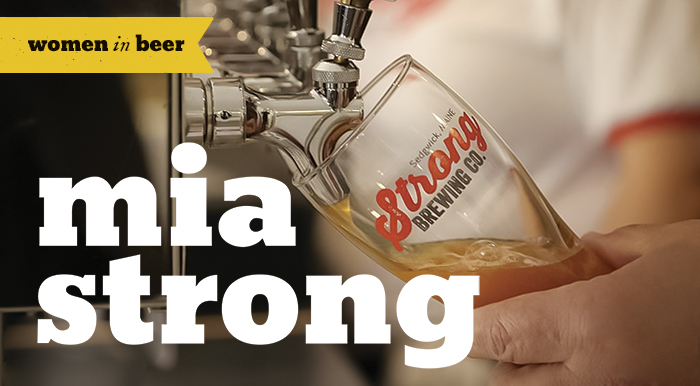
Strong Brewing Company: Beer Geeks to the Core

Take a tough Jersey girl with a tender spot for great beer, transplant her to Maine years later, and what do you get? A woman ready to take on the world of craft beer.
Meet Mia Strong, who with her husband Al, owns their tiny craft brewery in Sedgwick, Maine. Opened in 2013, Strong Brewing Company, whose motto is, “Beer geeks to the core…we brew what we like and we like everything,” has already grown in small leaps and bounds, completing a third expansion just this March.
Strong Brewing Company was the product of hard work and crowd-sourcing, including a successful Kickstarter campaign and a Community Supported Brewery, similar to a CSA. While Mia currently runs the business/operations end and Al makes the beer, she will soon train to brew on their new system. One can only wonder what beer styles she has in mind.
I caught up with Mia recently and peppered her with questions about how her love affair with beer began. “My mother was drinking Paulaner when I was in my teens. I snuck one of her beers and liked it. So long  to the Old Milwaukee I pretended to drink with my friends, dumping it out when they weren’t looking. A few years later I discovered Old Rasputin from North Coast. I took a four-pack of it to a party and a guy told me, ‘Girls don’t drink beer like that.’ I had a few choice words for him to set him straight.”
to the Old Milwaukee I pretended to drink with my friends, dumping it out when they weren’t looking. A few years later I discovered Old Rasputin from North Coast. I took a four-pack of it to a party and a guy told me, ‘Girls don’t drink beer like that.’ I had a few choice words for him to set him straight.”
In four years, the Strong Brewing Company has expanded twice, upgrading the brewing equipment, adding a tasting room, partnering with two food trucks and working to attract a third food vendor for summer, 2017.
I ask the million-dollar question: is there room for growth in the craft beer business?
Mia tells me, “I agree with the Brewers Association that we have only 12.2% of the beer market, so there’s plenty of room to grow. The diversity in styles is great for beer drinkers.”
“We’re not afraid to try new recipes and we listen. Last summer, people were asking for a stout. We switched up our production schedule in order to brew one to have on tap.” Mia has two kids, so I wonder what’s on tap at dinner time, for the adults, of course. What beers pair with comfort food like mac and cheese? “Something light, like our California Common Ale called Locomotive.” I’ve had it, and I agree. Goes great with clams and lobster, too.
— Kate Cone is the author of What’s Brewing in New England, (Downeast Books, 2016). She is currently working on a book about her search for her Irish ancestors and the beers they drank. Contact her at kateconewrites@gmail.com

Five Maine Running Groups
Find running camaraderie on the trails and the road
Warm weather brings all the runners out, from the mighty fast marathoners to the easy-going jog-walkers. And while solitary runs on local trails suit plenty of folks just fine, running with a group has perks, too. Running groups are supremely social (which often translates to making new friends), and running with other people supplies a level of motivation that’s hard to summon on our own. Many of Maine’s running groups are free to join, or have a nominal annual membership fee, and most of them run year-round, too (sometimes in snowshoes).
Maine Track Club
Maine Track Club has gathered local runners together since 1979. Open to all level, MTC has groups in several towns, including South Portland, Cape Elizabeth, Gorham, Scarborough, Sabattus, and Yarmouth. They also organize several races a year, and members have access to training clinics and social events. Membership is $25 a year. Mainetrackclub.com
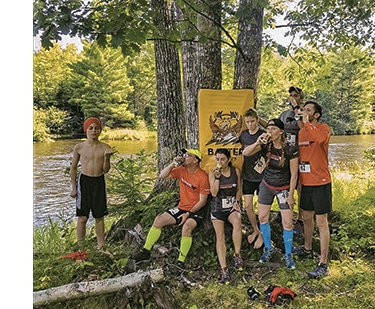
Photo: Emily Higgins-McDevitt
Trail Runners of Midcoast Maine
Trail Runners of Midcoast Maine is a free, year-round trail running group that meets a couple times a week in the Camden area (in warmer months, they usually run the trails at Camden Snow Bowl). Monday Night Dirt is a no-drop group run, which means beginners won’t feel left in the dust, and there are also runs on Wednesday and weekends. Find them on the web or on Facebook.
Old Port Pub Run
Old Port Pub Run is perfect for Portland-area runners who are motivated by post-run beers. The group meets at 6:15 p.m. every Thursday, year-round, at Liquid Riot Bottling Company in Portland. Runs range from 3 to 5 miles, and socializing back at the bar follows. The group is free, but bring money to buy your own beer. www.oldportpubrun.com
Fleet Feet Maine Running
Fleet Feet Maine Running offers run groups its locations in Brunswick and Portland. The $75 fee includes three days of running (Tuesday, Thursday, and Saturday), coaches, a year-long training program, and informational clinics. www.fleetfeetmainerunning.com
Trail Monster Running
Trail Monster Running is for serious trail runners who aren’t shy of rain, mud, and snow. Membership is “paid in the form sweat and blood on the trails,” which means you become an official member by showing up to run and volunteer. How fast you are doesn’t matter – the love of trail running does.
trailmonsterrunning.com
Central Maine Striders
Central Maine Striders in Waterville, established in 1975, connects runners of all levels, from recreational runners to competitive racers. The $15 yearly membership fee is good for the whole household and includes discounts for club races and access to group runs and training programs.
www.centralmainestriders.com
— Text: Shannon Bryan
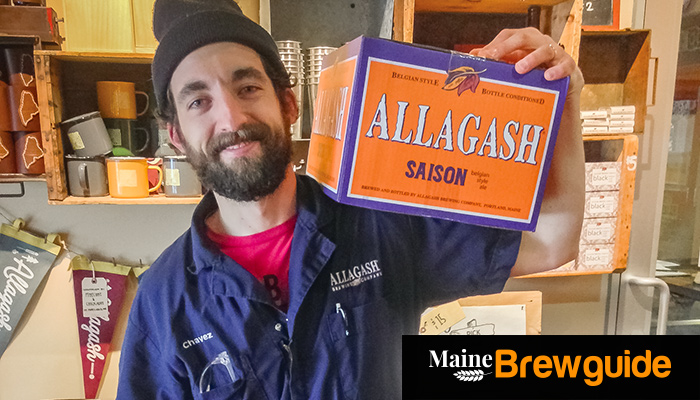
Saisons with a Twist
Since last spring I’ve had a love affair with saisons. I had always been a casual fan of the earthy, dry saison style, but last year it turned borderline obsessive. Each time I stood in front of a beer cooler, I’d find myself uncontrollably drawn to the saisons’ siren song.
As a long-time homebrewer, when I become smitten with a style of beer, I’m inclined to brew a batch in my kitchen. Homebrewing allows me to get intimate with a beer style, becoming acquainted with its nuances from the inside out.
But like that green-eyed, enigmatic girl at a school dance, the saison intimidated me. Saisons get the heft of their flavor from yeast. The beers I’ve traditionally brewed are hop-forward ales.
Luckily, two of my favorite saisons are brewed in Maine: Allagash Saison from Allagash and Farmhouse Pale Ale from Oxbow.
On a snowy day in late winter, I sit down with Allagash brewer Patrick Chavanelle at the Industrial Way brewery in Portland to get some tips on how to work with the sexy, if not unruly, saison yeast.
Clad in a one-piece brewing suit, Chavanelle explains that he originally brewed the Allagash Saison as a homebrew beer when he was hired at the brewery. Head brewer, Jason Perkins, liked the homebrew, and the Allagash team spent two years piloting batches before they settled on a final recipe for their dry, citrusy saison.
“The most important part of working with saison yeast is controlling the fermentation temperature,” Chavanelle states.
With most saison yeast strains, a homebrewer can achieve a range of flavors depending on the fermentation temperature.
High fermentation temps, in the mid-eighties for example, bring out spicy, funky flavors from the phenols, though fermenting too high can produce plasticy, band-aid-esque off flavors. Lower fermentation temperatures around seventy degrees bring out fruity flavors. However, if you ferment too low, the yeast will stall and homebrewers won’t get the proper attenuation to produce a dry finish—a vital saison characteristic.
Recognizing the frightened look on my face, Chavanelle assuages my fears by explaining that a fermentation temperature around seventy-five degrees will bring out the spicy, fruity saison flavors I’m looking for.
With growing confidence in my understanding of saison yeast, I contact Tim Adams, head brewer and owner of Oxbow Brewing Company, to help me better wrap my head around hopping a saison.
“You can use as much hops as you’d like, but be careful about when you add them to the boil,” Adams cautions. “The biggest problem you can encounter is making the beer too bitter.”
Adams continues that the longer a hop boils the more bitterness gets extracted from the isomerization of the alpha acids in the hops. When I explain that I’m interested in adding American hops to my saison for lush citrus flavors, he advises I add the majority of my hops in the whirlpool at the end of the boil and in dry-hopping. This advice saves me from making the mistake of over-hopping my wort at the start of the boil.
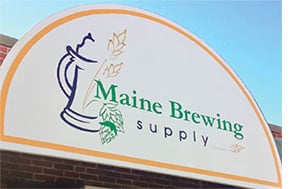 I’m now ready for my last stop before homebrewing: Maine Brewing Supply in Portland to consult with homebrewing Zen master Gordon Jones.
I’m now ready for my last stop before homebrewing: Maine Brewing Supply in Portland to consult with homebrewing Zen master Gordon Jones.
When I utter the word saison to Jones, a twinkle appears in his eyes; I know I’m talking to a kindred spirit.
“Saisons are the best style of beer to play with, because you have so many flavor components going on,” Jones states.
Clarifying the type of saison I want to brew, Jones rattles off a half dozen saisons brewed in the U.S. using domestic hops.
During this discussion, the Amarillo hop continually comes up. With bold flavors of oranges and grapefruit, Jones explains that many brewers turn to the Amarillo hop to get a clean, citrus interplay with the funky saison yeast.
Recalling that Tim Adams had mentioned the Centennial hop as a good choice for saisons, Jones and I put together a hop schedule of Amarillo and Centennial hops, saving all the hops for five minutes left in the boil, the whirlpool, and dry-hopping. Eschewing the bittering stages of the boil altogether.
Jones suggests Wyeast 3711 French Saison, a hardworking yeast strain known for its ability to work through residual sugars to create the dry finish I crave.
Keeping the malts simple—six pounds of extract pilsner malts and one pound of crushed wheat—will allow the French saison yeast and the American hops to shine in this homebrew.
My brewing partner, Tim Ebersold, and I head off to brew our saison. Imagine a month-long movie montage of us boiling, steeping, spilling, bottling, and impatiently waiting while Tom Petty sings, “The waiting is the hardest part.”
After five weeks, I wistfully crack open a bottle, and there it is: the spicy, funky aroma of saison yeast. There’s a nice bouquet of hop citrus flavors from the Amarillo and Centennial hops when I sip the saison, but they don’t get in the way of that beautiful French saison yeast. As the warm weather hits New England, brew up a saison and let the dry, fruity flavors accentuate your summer days.
— Text & Photos: Dave Patterson
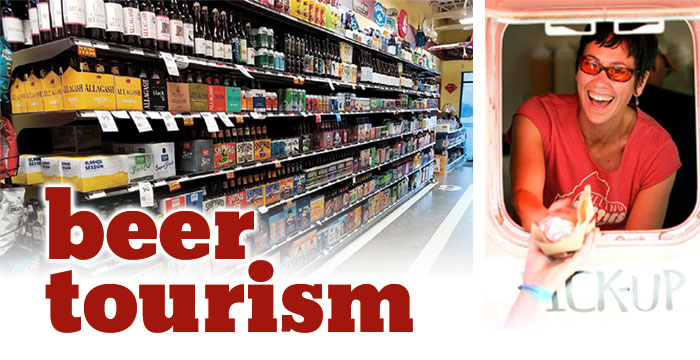
Maine vacations built specifically around breweries
In recent years, I’ve gotten into the habit of counting license plates at big beer releases. Specifically, I’ve been checking out how many out-of-state plates are mixed in among the Mainers seeing what’s new from their local brewers. More and more, the number of people “from away” dwarfs the locals. There’s always a reliable contingent of Massachusetts folks, followed closely by flannelled Vermonters and our neighbors from New Hampshire. But Maine beer is drawing drivers from further and further away. On release days at Allagash and Bissell Brothers, you’ll increasingly see people coming from as far as New York, Pennsylvania and even Virginia.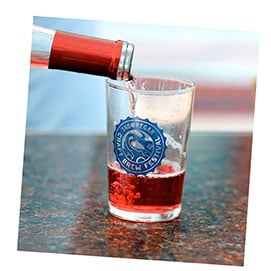
Beer tourism — that is, trips and vacations with an itinerary built specifically around breweries — is booming in Maine and around the country. The Brewer’s Association (the trade association for small and independent American brewers) estimates that about ten million people visited craft breweries last year, and that number is only rising. With over 90 breweries operating in the state, and one of the highest concentrations of breweries per-capita in the country, Maine is at the forefront of the world of “beercations.”
“During 2016, 85% of the 5,300 guests on board came from places other than Maine,” says Don Littlefield, General Manager of the craft beer tour company the Maine Brew Bus. And these visitors weren’t here just to try Maine beer, but to take it home. “Over a 12-month period, our tour guests purchased over $50,000 in additional spending for beer and merchandise to bring home.”
These purchases of beer (either for consumption or to-go) at breweries are big business — the Brewer’s Association reports that about 7% of total brewery beer sales are made at a brewery or in a tasting room. Littlefield suspects the rate is much higher in Maine, with “75% or more of sales” for some brewers coming from direct interaction with customers at their breweries.
BEST BEER STORES
[ezcol_1third]
Bangor Wine & Cheese
Belfast Co-op
Bier Cellar
Bootleggers
Bow Street Market
Global Beverage Warehouse
[/ezcol_1third] [ezcol_1third]
Good Beer Store
Madden Beverage
Maine Beer and Beverage
Oak Hill Beverage
Old Port Spirits & Cigars
Rising Tide[/ezcol_1third] [ezcol_1third_end]
Rockland Food Service
Ron’s Market
RSVP
State Street Wine Shop
Tully’s Beer and Wine
The Vault[/ezcol_1third_end]
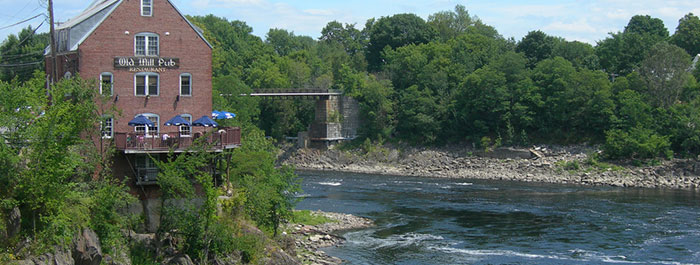
Maine is called “Vacationland” for a reason — tourism is practically the state’s raison d’etre — and has been part of the state’s brewing landscape since the first lobster-branded phial of Geary’s Pale Ale rolled off the bottling line in the ’80s.
On top of this, the brewers of the Pine Tree State are making great beer. Beer so great, in fact, that it’s highly sought after outside of our borders. And with the majority of the state’s brewers only distributing within Maine (and many distributing themselves, only within a few dozen miles of the brewery), demand for Maine-made beer straight from the source is at an all-time high.
“Visitors from out-of-state have been a big part of the people who walk into our tasting room since we’ve opened, and it has only grown since then,” says Tina Bonney, Business Manager at Foundation Brewing Company. “It’s great to see interest in Maine beer grow, not only because we love to share what makes the beer scene here great, but it’s also a chance to share other cool things that are going on here, and why we love calling Maine home.”
While demand is peaking now, it’s not a new story. For years, the largest beer sites online (Ratebeer, BeerAdvocate, and Reddit’s r/beer) have hosted forums for beer-lovers looking to share their local beer. If you’ve ever looked on these sites, or even on Facebook and social media posts, you’ll see the popular acronyms FT (“For Trade”) and ISO (“In Search Of”) floating around every local beer release.
In the early 2000s, Bar Harbor Brewing’s Cadillac Mountain Stout was among the most highly sought-after beers from Maine. The dry stout, voted best stout in the world in the World Beer Championships in 1995, topped plenty of “best beer” lists and turned lots of people onto Maine beer. Also in high demand at the time was Shipyard Brewing Company’s Pumpkinhead, a divisive spiced beer that had devoted fans willing to go to great lengths to get their favorite seasonal beer as the days got shorter. Demand also rose for Allagash Brewing Company’s Belgian-style brews, particularly after 2010 as they began releasing small-batch beers brewed in their Coolship (a broad, open vessel used to cool spontaneously fermented sour beers). The Coolship beers age particularly well, and Coolship Resurgam, Coolship Red, Coolship Cerise, and Coolship Balaton, among others, remain in high demand by beer-lovers around the country.
In recent years, the fervor over beer releases has shifted in a hoppier direction. While bold stouts still demand some attention (Rising Tide Brewing Company’s Nikita and Tributary Brewing Company’s Mott The Lesser are two such examples), IPAs, Double IPAs, and cloudy “New England IPAs” draw hundreds of visitors to releases. Foundation’s Epiphany IPA and Maine Beer Company’s Dinner Double IPA both draw massive crowds at each release, creating snaking lines of visitors down Industrial Way and Route 1. Demand for Bissell Brothers’ Substance has been astronomical since they started brewing, but every new release from the brewery draws scads of people to their spot-on Thompson’s Point. The brewery releases a schedule of can releases seasonally, and there seems to be a line no matter the release.
In addition to the demand seen at Maine’s breweries and taprooms, Maine beer retailers see visitors looking to bring home local beer (or trade it with friends near and far). “When we wrote our business plan in 2011, we never foresaw how big beer tourism would be to our business,” says Greg Norton, owner of the state’s best beer store, Portland’s Bier Cellar. “Each year we see increasing numbers of out-of-staters coming in to Maine … It’s been amazing to see how much beer that has gone from our shop to other states and even countries.”
Norton has fostered a good relationship with local brewers, and his shop is a go-to spot for new releases from many Maine brewers, including the aforementioned Bissell Brothers, Foundation, and Allagash. He also advocates for other local beer that doesn’t have quite as much hype behind it. “I generally try to steer them to great examples of styles that may fly under their radar as well as crowd pleasing beers that are pretty universally loved. If it’s summer time, a nice Weiss beer or lager, in winter a porter or stout.”
Outside of Portland, beer stores represent both the greater Maine beer scene and their local brewers, many of whom might not be available in the Forest City. A stop at Tully Beer and Wine in Wells can get you beer from tiny Theory Brewing Company, for example, and Ron’s Market in Farmington carries growlers from local Tumbledown Brewing Company. Bottle shops in the expanding Bangor/Orono beer scene, like Bangor Wine and Cheese, carry bottles, cans and growlers that never make it to Southern Maine’s shelves.
Looking to enter the wild, wooly world of beer trading?
Be advised that shipping through the U.S. Postal Service is a strict no-no, while using carriers like UPS and FedEx is a bit more of a gray area. Forums on the popular beer sites are a great place not only to find trading partners, but also for advice on how best to package and ship your beer. Some bottle shops are also helpful, as sources for bottle shipping containers if nothing else. The short answer? Pack carefully, throw in some extra favorites, and don’t be a jerk. Use trading as an opportunity to share local favorites and receive the same from someone. If nothing else, think of it as a boxed-up beercation.
— Text: Josh Christie
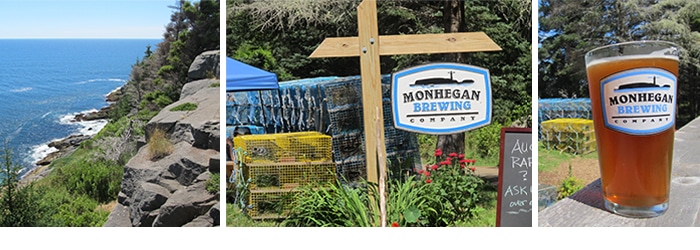
Visit an Island Brewery: Monhegan Brewing Co.
For you, dear beer, I would climb a mountain and cross the sea.
To grab a brew from Monhegan Brewing Co., it’s not like you can just drive up and hit the tasting room after work. This remote brewery is one of the few existing island stops on the Maine Beer Trail. You’re going to have to set aside an entire day for the journey, but it’s going to be the best damn beer you’ve ever tasted.
The entire experience starts from the moment you take the mailboat from the Monhegan Boat Line out from Port Clyde. For $35 round-trip, you can make the 7:00 a.m. or 10:30 a.m. ferry out and take the return 4:30 p.m. boat back, giving you an entire day to explore Monhegan’s extensive trails.
The official ferry season starts Memorial Day, but the crowds start to hit around July 4, so if you want it to feel as though you have the island to yourself, go any weekday or weekend before then. With roughly an hour crossing (10 miles out to sea), stand out on the top of the deck and let yourself experience full sensory overload; feel the bracing salty wind, the churn of waves and take in the porpoises, seals, and shags. Close your eyes and imagine everyone else you know sitting in an air-conditioned cubicle, trying to decipher an Excel spreadsheet. Try hard not to cackle out loud.
After the boat docks, you’ll instantly see why this place inspires so many artists. There are no crowds or cars. Barely any stores. Just million dollar views everywhere you turn and a reclusive sense of silence. Maine: the way life used to be.
Have a good pair of hiking boots and bring a backpack with snacks and water or grab what you need at the island’s only year-round grocery store, L Brackett & Son on the main road just before the post office.
Buy the trail map at the boat ticket booth because your smart phone won’t likely work here. For those who want to boost the enchantment factor, take the easygoing Cathedral Woods trail, which reveals many tiny handmade fairy houses built alongside the path. (Just don’t cheese off the locals and alter the natural landscape or leave any items like beer caps).
If you want to get the biggest reward for your beer hike, forgo the easy trails and head straight for the cliffs. A short jaunt down the south side of the main road will take you to a fairly good loop starting with Burnt Head #4, which winds through the hushed forested interior of the island. Cut to the left slightly to Gull Cove #5, which takes you through a jagged cliffside path, (known as Trail #1) a spectacularly rugged hike that spans the perimeter of the island.
When you come out on Lobster Cove on the south side of the island, you’ll be sweaty and tired, but it’s going to feel like the chorus of angels just busted out in a cappella when you see the shingled cape taproom of Monhegan Brewing Co.
Owners Matt and Mary Weber started this family-owned brewery in 2013 and for the last three summer seasons, have seen traffic and sales exponentially increase. “The first year, people would sort of stumble onto the brewery, but now, especially with The Maine Beer Trail, we’re seeing more and more people come over specifically to go for a hike and sample a brew,” she said. “You earn your beer, that’s for sure.”
The inside of the taproom feels like a rustic clubhouse with cheerful blue and white decor and features about five to six brews ranging from IPAs and pale ales to a stout.
One of their most popular summertime brews is the Balmy Days Citra-Hopped Kölsch. After those cliffs, the light citrusy body with a touch of wheat is going to taste like Nirvana in a glass, no joke.
“A lot of people have told us it’s the best beer they’ve ever had, said Mary. “As much as it pleases me that they like our brews, I have a feeling that being hot and sweaty and having a cold beer at the end of the trail has a lot to do with it,” she laughed.
Each brew ranges from $5.00 – $6.00 per pint and they also offer handcrafted ginger beer and root beer as well. They take both cash and cards, but islanders always appreciate cash.
At this taproom, there is no such thing as a stranger. Many of those who came over on the ferry with you will end up here, or you might see an islander wheel up on an ATV to fill a growler. Mingle on the taproom steps or wander out to a shaded table in their lobster trap beer garden.
Out of all the day trips you take in your lifetime, you can honestly say you never went this far out of your way for a beer.
Okay, kick back and take a sip. You can die now.
— Text & photos: Kay Stevens
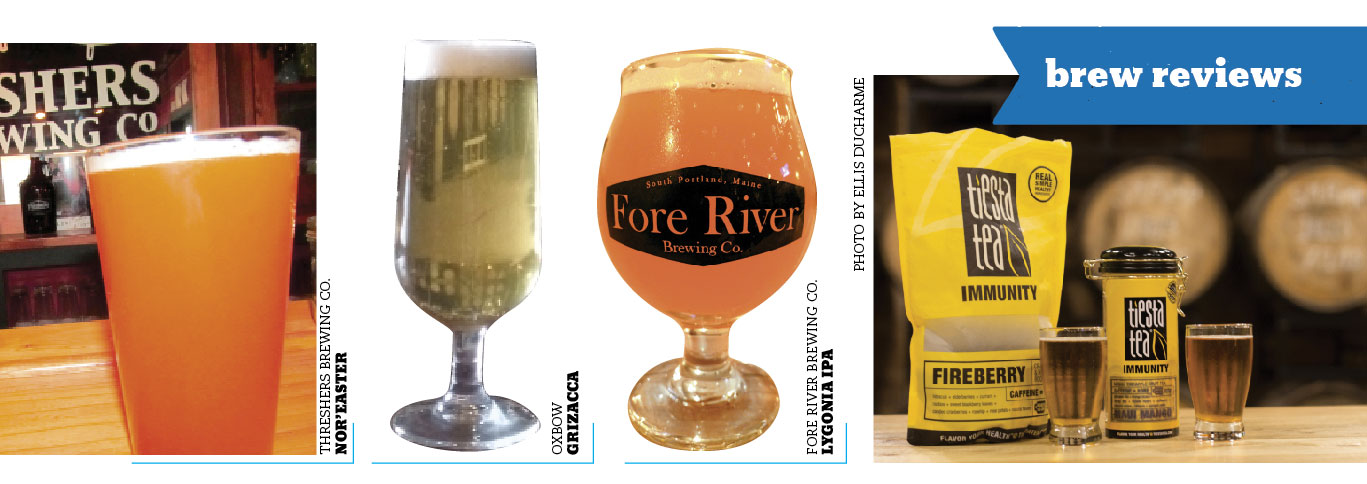
Summer Beers You’ll Want to Try
Maine BrewGuide reviews 5 summer beers from local breweries
Oxbow Brewing Company ~ Grizzaca
5% ABV
Kissing cousin to a Saison, Grizacca is Oxbow Brewing Company’s interpretation of the Belgian style beer called grisette. There is an infinite amount of lore surrounding this style, but it doesn’t have to get complicated: while saisons were made for farmworkers, grisettes were brewed for coal miners. Simple, until you find references to “grisettes,” young working women dressed in gray, “gris” in French. Let’s stick to the beer. Sipping Grizacca with Anne Marisic, Oxbow’s Director of Retail Sales, at noon on a gray, er, gris Saturday, was a perfect example of why we go to tasting rooms. Once inside, the world becomes smaller, the outside no longer bothers our consciousness. We are talking beer and drinking it. Grizacca is bright, crisp, with notes of pineapple and hints of the promise of spring. Ahhh. A must-sip beer for the spring and summer season. Watch for Rivulet in Summer, 2017, their newest grissette.
Threshers Brewing Co. ~ Nor’easter
5% ABV
In the springtime, on a day that just breaks 50 degrees, if you happen to be sitting outside on the patio at Threshers Brewing Co. in the deep woods of Searsmont, just kick back, prop up your Muck Boots and gaze at the bare trees and muddy parking lot. Then take one sip of their Nor’easter and close your eyes. You’re on the beach, baby, and it’s fast forward to summertime. This Northeast style IPA is made with a Vermont-style ale yeast, which lends some cloudiness to the honey color and the Australian El Dorado hops smooth it out without any trace of bitterness. It starts with citrusy, almost naval orange flavor, which gives way to a juicy, clean finish—sort of like a breath of clear, cool air on a hazy, summer day.
Shipyard Brewing Co. ~ Fire Berry & Maui Mango Blend
5% ABV
Tea beers are currently trending in Europe, with Germany being the epicenter for tea blending these days. Fortunately you don’t have travel far to experience Shipyard’s two options, Fire Berry and Maui Mango Blend. Both of these tea beers are wheat based and low in alcohol to allow a neutral canvas so when the teas are blended it allows the elements of the natural tea ingredients to come through. Oh, and caffeine-free!
The tea used is from Tiesta Tea, who has highly researched and selectively sourced teas from around the world for the best characteristics and flavor. The Maui Mango Blend: Has an aromatic nose that presents with notes of pineapple, orange slices and strawberries. The flavor has a pleasant juiciness and is not overpowering, it leaves you with a clean, crisp finish. Fireberry: A more tea forward beer, is made with blackberries, elderberries, currants and hibiscus and has a clean slightly bitter finish which I enjoyed.
In lieu of hops: Tea beers have achieved what is being done with hops these days. Today’s brewers are finding new ways to exploit the bountiful flavors from natural fruit and varying tea blends that allow full, complex flavors in sessionable beers.
Oxbow Brewing Co. ~ Loretta
4% ABV
The brainchild of Oxbow head brewer Mike Fava, Loretta resurrects the once-forgotten style of grisette. Originally brewed as a libation for French coal and stone miners centuries ago, the style is a close cousin to saison, similarly low in alcohol and refreshing. Loretta is one of three grisettes the farmhouse brewery produces – along with the La Griseta and Grizzaca – and the most traditional example of the style. Brewed with European hops and locally-harvested spelt grain, the light-bodied beer clocks in at an easy-drinking 4% ABV. Loretta pours a pale yellow with a big, estery nose, and is a crisp, refreshing mix of lemon, wheat and grainy sweetness with a slightly citric bite.
Fore River Brewing Company ~ Lygonia IPA
6.5% ABV
Lygonia’s golden hue glows like a July sunrise over Casco Bay. Its nose emanates a summer-rich aroma of peaches, grapefruits, and pineapple from the Ella and Topaz hops. As you sip Lygonia, (Fore River Brewing Company) tropical fruit flavors give way to refreshing pine notes until finally easing back to a mango hop finish. It has just the right sweet malt body to balance out the generous addition of hops, while the dry finish leaves little residual sugars to get in the way of its refreshing hop voyage. Lygonia is the perfect companion to backyard cornhole with friends while Tom Petty croons on the radio.
— Text & Photos: Grizacca – Kate Cone; Nor’Easter – Kay Stephens; Fire Berry & Maui Mango Blend – Stan Rintz; Loretta – Josh Christie; Lygonia IPA – Dave Patterson

Maine’s Cup Runneth Over
The State’s craft distillery movement is spilling over into its cocktails.

Photo: Wiggly Bridge Distillery
Did you know Maine was the birthplace of prohibition? Maine passed the first laws in the country to ban the sale of alcoholic beverages. If not being able to have your afternoon Old Fashioned doesn’t put a sour taste in your mouth, I don’t know what will.
As history states, the Maine prohibition law was repealed in 1934 and Maine residents were able to enjoy their afternoon beverage again and that’s pretty sweet.
Being part of Wiggly Bridge Distillery since its foundation, we see that the craft beer trajectory is being replicated by the craft spirits industry. According to the American Craft Spirits Association there are over 1,300 craft spirits producers nationally as of October 2016. That’s more than double the amount of craft distilleries that existed 10 years ago. This speaks volumes about the strong interest in craft spirits. This surge and uprising is no different for Vacationland. In 2009, there were only 3 distilleries in the state of Maine. Maine now has its own Distillers Guild and has 12 members mapped out on their website.

Photo: Wiggly Bridge Distillery
Maine is known for its pristine waters and aquifers. Not connecting that fact, in reference to this rum punch rhyme, would be doing the State a disservice.
The craft movement has become a huge part of our society not only in Maine, but nationally. The United States seems to be infatuated with artisanal everything, from handcrafted furniture to homegrown organic food to hand crafted chair socks. Yes, you read that right! Look it up. Now that the bulk of the alcoholic offerings behind the bar have been upgraded by the craft movement, it’s time to upgrade the ingredients that play nicely with these craft spirits. The term “fresh is best” rings true for the craft cocktail scene. Bartenders are juicing their own citrus instead of using something that’s pre-made. Ian Michaud, distiller from Liquid Riot, can attest to the fact that craft spirits have opened the doors to the craft cocktail scene. “Craft cocktail makers pride themselves in creating their own mixers, bitters, shrubs, syrups etc. The variety and quality of craft spirits now available to these mixologists allows them a level of freedom to create so many amazing libations!”

Liquid Riot / Yo Yo Nana
Ashleigh Hamilton, Lead Mixologist, from Wiggly Bridge Distillery, believes that the cocktails play off the complexities in craft spirits. “When creating a cocktail with a craft spirit the flavors are accentuated and create a more interesting cocktail while a commercial spirit may cause the cocktail to fall flat.”
Ned Wight, owner of New England Distilling, believes that craft spirits give the bartender more nuanced flavors to work with in a cocktail than a regular spirit. “It’s like they [bartenders] were working with a 4 pack of crayons 10 years ago and now they have the mega-pack (with sharpener!).”
The next time you sip a rum punch or an old-fashioned, think about what’s in your drink. Try out one of Maine’s incredible craft distillery options and enjoy the exponential flavor experience you get from drinking a craft cocktail. Your taste buds will start to appreciate the difference between a craft cocktail made with local craft spirits and one that has just come out of a soda gun.
— Text: Amanda Woods
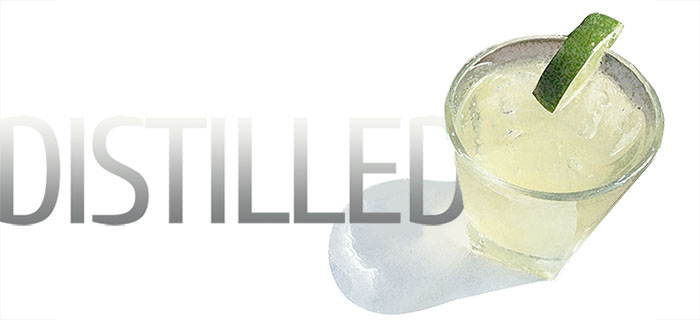
Distilling in Maine: Ingenuity, Craft, and History
It’s mid-afternoon on a Saturday and I’m in an up-and-coming industrial neighborhood in one of Maine’s coastal towns, enjoying a drink. It’s Maine Craft Distilling’s take on a Moscow Mule, served with their spiced Ration Rum, ginger beer, and lime juice. Or perhaps it’s peppery Gunpowder Rye from New England Distilling, served straight up along with a tour of the distillery. I could be in Biddeford’s Pepperell Mill sipping a Bimini Special—a refreshing tonic made with Round Turn Distilling’s Bimini Gin, coconut water, lime juice, and a dash of bitters. The spirits may vary, but one thing is consistent: these craft distilleries are helping to bring life back to once-neglected industrial spaces as part of a resurgence of distilling in Maine that hasn’t been this robust since before Prohibition.
Craft distilleries and their accompanying tasting rooms are following in the well-trod steps of craft breweries. Fifteen distilleries have opened in Maine in the last 11 years, wrestling consumers’ attention away from national brands with carefully crafted, often locally-sourced products in a wide array of styles. Like breweries, the forerunners of the industry worked to change unfavorable laws leftover from the 1930s for their businesses to thrive. And it’s working—as regulations become friendlier to small businesses and the public’s thirst for craft beverages grows, more and more distilleries are firing up their stills and slinging drinks across the tasting room bar.
Distilling in Maine was actually outlawed for the longest period of time in the country—from the passage of the so-called Maine Law in 1851 until the repeal of Prohibition in 1933—a total of 82 years. It should follow then that near every distillery in Maine gives a nod to history by revitalizing forgotten spaces. Distillers work in once-abandoned mills and warehouses in Portland, Brewer, Biddeford and in renovated barns in York, Freeport, Union, and Newcastle. They create spirits that honor our state’s rich history of shipyards, working waterfronts, and agriculture in these spaces made relevant once again.
Of course, no one narrative captures the wide variety within Maine’s craft distilling industry. The men and women behind the stills produce unique spirits using technology that was first discovered in Medieval times, but given a 21st century twist. Unwanted potatoes become gin and vodka at Maine Distilleries; Split Rock Distilling ferments and distills locally-grown organic grains into vodka and bourbon. Several distilleries use molasses to make a number of rums as varied as those from the Caribbean Islands, and gins are flavored with unique botanicals like chamomile, rose petals, and naturally, blueberries. There’s a Maine-made spirit for everyone from fruity mixed drink lovers to serious whiskey aficionados.
As the Maine craft distilling industry grows, so does the average drinker’s knowledge of spirits. Bespoke cocktail menus featuring bitters, amaros, egg white-topped drinks, and housemade ingredients have helped turn many average bar-goers into a knowledgeable and discerning consumers. Others are simply happy to try something new that tastes good, and many are looking to connect with the story behind the drink. As a result, the last few years have seen a rise in the popularity of events and groups that offer drinks with a side of education.
The Portland Spirits Society (of which I am the founder) hosts ladies-only educational events about different styles of liquor. We’ve learned about everything from tequila and Scotch to what kind of whiskey pairs well with chocolate. Briana Volk, owner of the Portland cocktail bar Portland Hunt + Alpine Club, coordinates the New England Cocktail Conference annually, a multi-day event for industry professionals and the public. The conference’s events in years past ranged from tiki drinks 101 to a “grandpa drinks”-themed retro dinner.
A natural extension of the farm-to-table ethos that has gripped our nation’s food, craft distilling has what’s missing from those ubiquitous national brands: a unique sense of place. People want a drink with a story, and the ingenuity and craft that has long characterized the makers of our state fills every bottle. So next time you order a drink at a bar, ask what’s local, and listen for the unique story that only a Maine-made spirit can tell.
— Kate McCarty is a food and drink writer living in Portland, Maine. She has written two books, including Distilled in Maine: A History of Libations, Temperance, and Craft Spirits. Find more of her writing at blueberryfiles.com.






